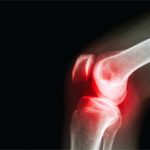(Reuters Health)—Young adults who have had knee injuries are much more likely than uninjured peers to develop knee osteoarthritis (OA) by middle age, especially if they have broken bones or torn connective tissue, a recent study suggests.
Cruciate ligament injuries were associated with a 19.6% greater risk of knee osteoarthritis, the study found. Meniscal tears were associated with a 10.5% greater risk of osteoarthritis, and fractures of the tibia plateau or patella were associated with a 6.6% greater risk.
Researchers followed almost 150,000 adults aged 25–34 years old, including about 5,200 with a history of knee injuries, for almost two decades. Compared with people who never had knee injuries, those who did were 5.7 times as likely to develop knee OA during the first 11 years of follow-up and had 3.4 times greater risk over the next eight years, the study team reports in the British Journal of Sports Medicine.1
“Injuries that occur inside the knee joint, for example in the meniscus or cruciate ligament, may alter the biomechanical loading patterns in the knee,” lead study author Barbara Snoeker, of Lund University in Sweden, says by email. “In other words, such injuries may lead to an ‘imbalance’ in force transmissions inside the knee joint, consequently overloading the joint cartilage and leading to increased risk of developing osteoarthritis, compared to injuries that mainly affect the outside of the knee joint, such as contusions.”
After 19 years of follow-up, a total of 422 people with knee injuries, or 11.3%, developed knee osteoarthritis. So did 2,854, or 4%, of people without any history of knee injuries.
Most often, injuries involved multiple structures of the knee. This accounted for 21% of participant knee injuries. The second most common type of injury was cuts and contusions, at 18%, followed by cartilage or other tissue tears at 17%.
One limitation is that injuries involving multiple structures in the knee may have been underreported, leading researchers to underestimate the risk associated with these types of injuries, Jonas Bloch Thorlund, a professor of musculoskeletal health at the University of Southern Denmark, in Odense, who wasn’t involved in the study, said by email.
Another limitation is that researchers didn’t look at body mass index (BMI), so they couldn’t know whether patients’ weight explained their risk of OA, says Kyle Hammond, MD, of the Emory Sports Medicine Center, Atlanta.
What happens after knee injuries can also influence the risk of OA down the line, Dr. Hammond, who wasn’t involved in the study, says by email.
“Counseling a patient on how to safely and consistently return to a positive fitness program, ensures that they will maintain flexibility and strength, as well as keeping their weight at their ideal body weight,” Dr. Hammond says.
Rehab matters regardless of what other treatments patients receive, says Adam Culvenor, a sports and exercise medicine researcher at La Trobe University in Bundoora, Australia, who wasn’t involved in the study.
“Once these injuries occur, optimally managing them with an intense and progressive period of rehabilitation under the guidance of a physical therapist [irrespective of the decision to have surgery or not] to strengthen the muscles around the knee to facilitate a return to function and physical activity is likely to reduce the risk of osteoarthritis and persistent symptoms longer-term,” he says by email.
Reference
- Snoeker B, Turkiewicz A, Magnusson K, et al. Risk of knee osteoarthritis after different types of knee injuries in young adults: A population-based cohort study. Br J Sports Med. 2019 Dec 11. pii: bjsports-2019-100959. doi: 10.1136/bjsports-2019-100959. [Epub ahead of print]
